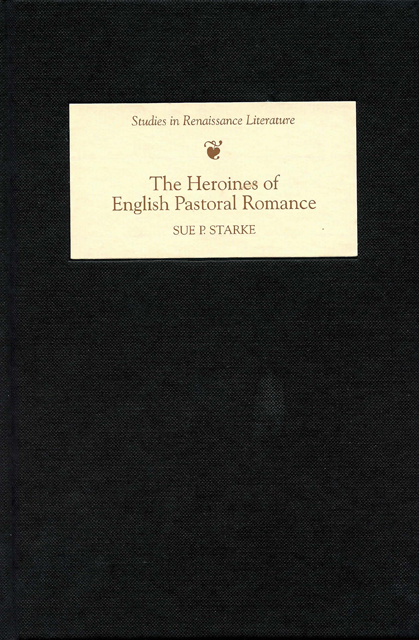Book contents
- Frontmatter
- Contents
- Acknowledgements
- Abbreviations
- Chapter 1 The Pastoral Romance Heroine in English Renaissance Literature
- Chapter 2 The Arcadian Prison: Chastity and the Defense of the Princesses in Sidney's Two Arcadias
- Chapter 3 Spenser's Romance Heroines: The Heroic and the Pastoral in Books 3 and 6 of The Fairie Queene
- Chapter 4 Growing Out of Pastoral: Wroth's Urania and the Female Pastoral Career
- Chapter 5 Fletcher's Clorin and Milton's Lady: The Performance of Chastity in Pastoral Drama
- Chapter 6 Milton's Eve and Marvell's Maria Fairfax: Wives and Daughters in the Pastoral Family Circle
- Bibliography
- Index
Chapter 1 - The Pastoral Romance Heroine in English Renaissance Literature
Published online by Cambridge University Press: 10 March 2023
- Frontmatter
- Contents
- Acknowledgements
- Abbreviations
- Chapter 1 The Pastoral Romance Heroine in English Renaissance Literature
- Chapter 2 The Arcadian Prison: Chastity and the Defense of the Princesses in Sidney's Two Arcadias
- Chapter 3 Spenser's Romance Heroines: The Heroic and the Pastoral in Books 3 and 6 of The Fairie Queene
- Chapter 4 Growing Out of Pastoral: Wroth's Urania and the Female Pastoral Career
- Chapter 5 Fletcher's Clorin and Milton's Lady: The Performance of Chastity in Pastoral Drama
- Chapter 6 Milton's Eve and Marvell's Maria Fairfax: Wives and Daughters in the Pastoral Family Circle
- Bibliography
- Index
Summary
Introduction
The romance genre in the Renaissance is known for its mixed properties; its associations are both high and low, martial and erotic, masculine and feminine, humorous and heroic. This capacious form, however, has been considered the most important secular genre of the age. The purpose of this study is to examine one key aspect of romance's efflorescence in Renaissance England: the enduring vitality of pastoral romance between 1590 and 1650. This strand of romance, influenced by a newly discovered appreciation for fifth-century Greek romances, was particularly well received in aristocratic and gently born circles, while versions of medieval chivalric narrative cycles remained more popular with middle-class readers. Why was this so? In English Renaissance pastoral romance, I will argue, the preservation and well-being of the family come to depend upon the vital presence and moral authority of the virginal aristocratic daughter. Under her aegis, the attractive but potentially enervating otium of Italian Renaissance pastoral is transformed into a morally regenerative experience of productive retreat within the bosom of the gentle family. From Sidney's The Countess of Pembroke's Arcadia through Marvell's pastoral lyrics, we may see the early development of an ideal of aristocratic domesticity: the pastoral locus amoenus becomes the residence of a nuclear familial unit revolving around the daughter. The writers included in the study use their heroines’ relationships to pastoral romance themes as indices of moral development, for herself and for her kin. Despite their formal differences, these works share two common traits: the centrality of pastoral in the construction of the text's social ethos, and the importance of the romance heroine as a reflection of the poet's pastoral vision.
The romance itself was associated with women in the English Renaissance, offering an appropriate means of transmitting pastoral values in a different generic context from that of traditional lyric. Of course, the vast majority of romances in this period, including pastoral romances, were written by men, with Lady Mary Wroth the notable exception. There has been some debate about the extent to which we may associate women readers with the rise of prose romance fictions; nevertheless, the courtly code of manners surrounding the introduction of such works to the reading public frequently invoked the importance of securing a favorable critical reaction from an imaginary feminine audience.
- Type
- Chapter
- Information
- The Heroines of English Pastoral Romance , pp. 1 - 40Publisher: Boydell & BrewerPrint publication year: 2007



